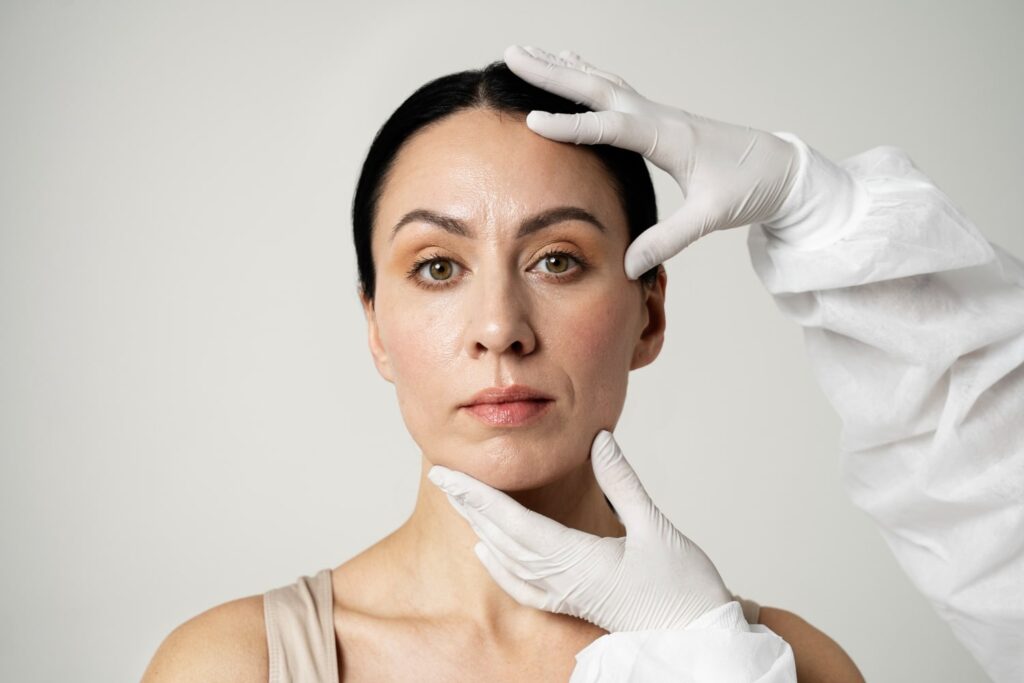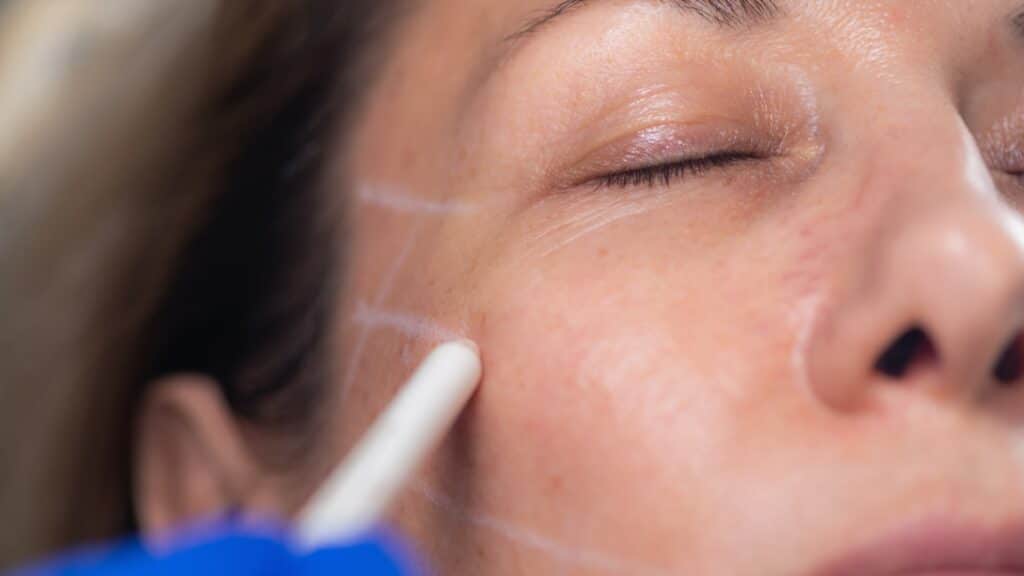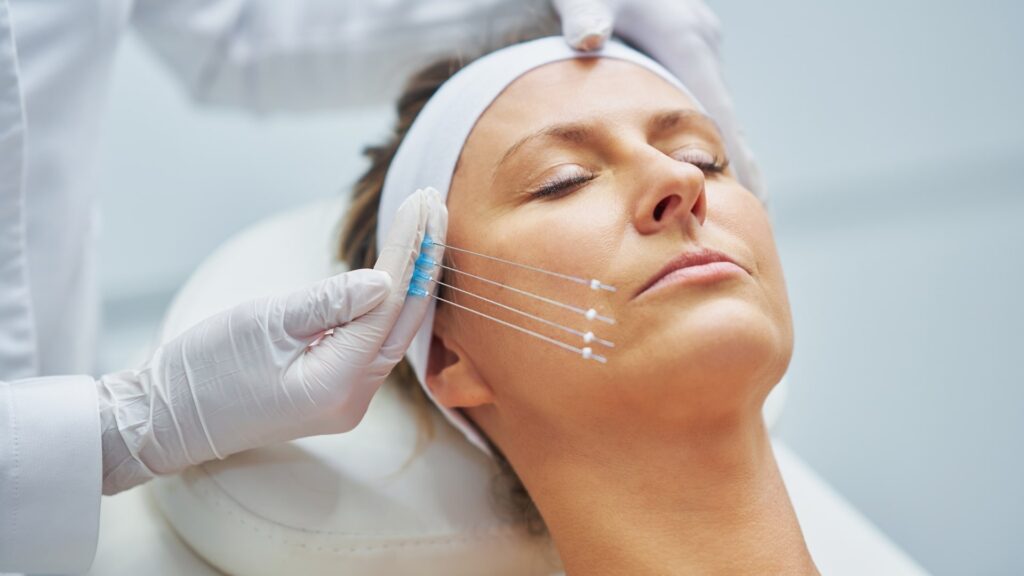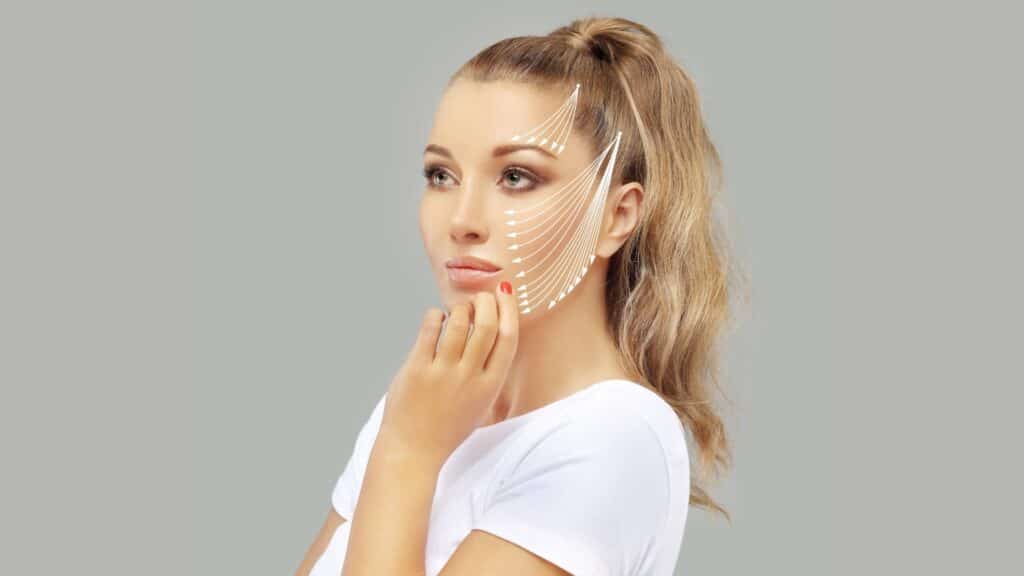Tired of your reflection showing the battle with gravity? As years progress, your skin’s foundation weakens—collagen dwindles, elasticity vanishes, and facial contours surrender to time. Those deepening folds and descending cheeks won’t respond to even the priciest creams.
Surgery feels extreme, with its anesthesia risks and weeks of recovery. Enter the PDO thread lift—the remarkable middle path that lifts, tightens, and rejuvenates without turning your life upside down.
Understanding PDO Thread Lifts
What is a PDO thread lift? PDO (polydioxanone) is a biocompatible, fully absorbable material that physicians have safely used in surgical sutures for years. Initially created for cardiac procedures, these medical-grade threads have since transformed aesthetic medicine through their skin-rejuvenating qualities.
Unlike permanent sutures, PDO threads naturally dissolve in your body over several months. The treatment works through two mechanisms: immediately lifting sagging tissue while simultaneously triggering your body’s natural collagen production for longer-lasting improvement.
Thread lifting procedures first appeared in the 1990s, but today’s PDO thread lift techniques have substantially improved. They deliver more natural results with less recovery time and fewer complications than earlier methods.
How PDO Thread Lifting Works
The PDO thread lifting procedure blends art and science in a relatively straightforward process. Let’s walk through what happens during a typical treatment:
Pre-Procedure Preparation
Before your appointment, you’ll likely be advised to avoid blood-thinning medications, alcohol, and certain supplements for 5-7 days to minimize the risk of bruising. Some providers photograph your face from multiple angles for precise before-and-after documentation.

Step 1: Mapping and Anesthesia
Your specialist begins by meticulously mapping the insertion points and thread pathways based on your facial anatomy and treatment goals. They’ll then numb the area with a topical anesthetic and possibly small injections of lidocaine at the entry points, ensuring your comfort throughout the procedure.
Step 2: Thread Insertion
Using either ultra-fine needles or blunt-tipped cannulas (thin, flexible tubes), the practitioner carefully introduces the PDO threads beneath your skin. The threads are inserted following predetermined paths that maximize the lifting effect while respecting anatomical structures like nerves and blood vessels.
The threads used in a PDO thread lift fall into three main categories, each serving specific purposes:
- Barbed/cog threads: These feature tiny directional barbs or cogs that hook into surrounding tissue like gentle anchors. When pulled and secured, they instantly lift and reposition sagging tissue. They’re typically used in areas requiring more significant lifting, such as cheeks and jowls.
- Smooth threads: Thinner and without barbs, these threads don’t provide immediate lifting but excel at stimulating collagen production. They’re often placed in a mesh-like pattern to create a supportive foundation beneath the skin and are ideal for finer lines and thinner skin areas.
- Twisted/spiral threads: These combine elements of both types above, with a unique twisted structure that provides moderate lifting while maximizing surface area for collagen stimulation. They’re particularly effective in areas requiring both support and rejuvenation.
Step 3: Positioning and Securing
Once inserted, the threads are carefully positioned to create the desired lifting effect. Barbed threads may be gently pulled to elevate sagging tissue before being secured. The ends are then trimmed so they remain completely under the skin, invisible to the eye.
Common PDO thread lift treatment zones include:
- Mid-face sagging and jowls for cheek elevation and jawline definition
- Nasolabial folds (smile lines) to soften deep creases
- Marionette lines around the mouth to address downturned corners
- Brow area for a subtle, non-surgical brow lift
- Neck laxity and the submental area (double chin) can improve the profile
- The upper chest area to address crepey skin and horizontal lines
Step 4: Final Adjustments
Your specialist will make subtle adjustments to ensure symmetry and optimal thread placement. They may also apply gentle pressure to shape the treated areas and finalize the thread positioning.
Most PDO thread lifting sessions take 30-60 minutes from start to finish, depending on the treatment zones and the number of threads needed. Many patients are pleasantly surprised by the procedure’s efficiency and manageable comfort level, describing it as considerably less uncomfortable than they anticipated.
Immediate and Long-term Effects
What is PDO thread lift treatment actually doing beneath your skin? Two key processes create its rejuvenating effects:
Initially, there’s a mechanical lifting action. The threads physically support and elevate the tissue, producing a subtle yet noticeable improvement immediately after placement.
The more significant benefits unfold during the months following treatment. PDO thread lifting activates your body’s natural healing response, boosting fibroblast activity and increasing production of:
- Type 1 collagen for improved skin strength and structure
- Elastin fibers for enhanced skin flexibility
- Hyaluronic acid for better hydration and volume
This biological regeneration process (neocollagenesis) continues for months as the threads gradually dissolve. While most PDO threads fully absorb within 4-6 months, their rejuvenating effects typically persist for 12-18 months due to this ongoing collagen stimulation.

PDO Thread Lift Before and After
Understanding the timeline of results is crucial when considering a PDO thread lift. The transformation unfolds in distinct phases, each offering different benefits.
Immediate Results (Day of Treatment)
Directly after your procedure, you’ll notice an initial lifting effect—this is the mechanical action of the threads physically supporting your tissues. Some patients may experience:
- A 1-3mm elevation in treated areas
- Subtle improvement in facial contours
- Initial tightening sensation
- Some swelling that actually enhances the lifting appearance temporarily
Short-Term Results (1-2 Weeks)
As initial swelling subsides, you might experience what specialists call a “settling phase.” Don’t be concerned if some of the immediate lift appears slightly reduced—this is normal. During this period:
- Any asymmetry typically resolves
- Tenderness diminishes
- The “pulled” sensation becomes more natural
- The true structural support of the threads becomes evident
Progressive Results (1-3 Months)
This is where the magic really happens. Your body responds to the threads by generating new collagen, elastin, and hyaluronic acid around each thread. During this phase:
- Skin texture improves significantly
- Fine lines begin to soften
- Facial contours become more defined
- A natural volumizing effect emerges from within
Peak Results (3-6 Months)
Most patients see their optimal results around the 3-6 month mark when collagen production reaches its peak. In PDO thread lift before and after comparisons at this stage, improvements typically include:
- Enhanced cheek projection and reduced hollowness
- A 2-4mm elevation of sagging tissues compared to baseline
- Up to 30% reduction in nasolabial fold depth
- Notably more defined jawline with diminished jowling
- Tighter skin across the neck and under-chin area
- Improved skin quality with enhanced luminosity and firmness
- More youthful facial proportions and balanced features
Results Longevity (6-18 Months)
While the PDO threads themselves dissolve within 4-6 months, the collagen framework they create continues supporting your tissues. Most patients enjoy improvements lasting 12-18 months, with some reporting benefits extending beyond this timeframe.
Factors Influencing Your Individual Results
- Age and skin condition: Younger patients with mild laxity often see more dramatic improvements than those with severe sagging or sun damage.
- Thread specifications: The number, type, and placement pattern significantly impact outcomes:
- 10-15 threads might be used for minimal lifting
- 15-30+ threads for more comprehensive treatment
- Strategic vector placement creates different lifting patterns based on your facial structure
- Collagen-producing capacity: Your body’s natural collagen production efficiency varies based on:
- Genetics (some people simply produce collagen more efficiently)
- Hormonal status (particularly relevant during menopause)
- Overall health markers and nutrition status
- Lifestyle factors: Your daily habits dramatically influence both immediate results and longevity:
- Sun protection preserves results (UV exposure degrades collagen)
- Smoking reduces oxygen to tissues and impairs healing
- Proper hydration and nutrition support skin regeneration
- Quality skincare enhances and maintains results
Potential Side Effects and Management
While PDO thread lifts are generally safe, being prepared for possible side effects helps ensure a smooth recovery:
- Bruising: It can vary from mild to more noticeable, particularly in sensitive areas or if you have a tendency to bruise. Arnica montana supplements or topicals may help speed resolution.
- Asymmetry: Temporary unevenness is common during healing and usually balances naturally. Avoid judging your final result until at least 2-3 weeks post-procedure.
- Puckering or dimpling: Small skin irregularities typically resolve within 1-2 weeks as threads settle. Resist the urge to massage these areas.
- Tenderness: Discomfort along the pathways is normal and diminishes gradually. Acetaminophen typically provides sufficient relief.
- Thread visibility: Occasionally, threads may be slightly visible under very thin skin. This resolves as the threads integrate with the surrounding tissue.
- Migration: Rarely, threads may shift slightly from their initial placement. Following aftercare instructions minimizes this risk.
Red Flags (When to Contact Your Provider)
While complications are uncommon with PDO thread lifting, contact your provider immediately if you experience:
- Severe or worsening pain not managed by over-the-counter medication
- Excessive swelling that increases after 48 hours
- Signs of infection (increased warmth, redness, or discharge)
- Significant asymmetry that persists beyond two weeks
- Thread exposure through the skin
- Any reaction to medications prescribed as part of your treatment
Long-Term Care for Extended Results
To maximize the longevity of your thread lift:
- Maintain consistent sun protection to preserve collagen
- Consider regular collagen-stimulating skincare ingredients (retinoids, peptides, growth factors)
- Stay hydrated and maintain good overall skin health
- Schedule maintenance treatments before results fully diminish (typically every 12-18 months)
- Consider complementary skin quality treatments that enhance thread performance
Most providers will schedule a routine follow-up appointment 1-2 weeks after your PDO thread lift to verify proper healing and address any concerns. This visit gives them the opportunity to assess your initial results and make recommendations for maintaining them long-term.

Ideal Candidates for PDO Thread Lifts
The best candidate for a PDO thread lift typically shows mild to moderate skin laxity but isn’t ready for surgery. While most patients are between the ages of 35 and 65, your specific skin condition matters more than your chronological age.
You might benefit from threads if:
- You’ve begun noticing skin laxity and sagging
- You prefer subtle, natural-looking improvement
- You can’t accommodate a lengthy recovery time
- Your general health is good
- Your expectations align with what threads can realistically achieve
Conversely, PDO thread lifting might not suit you if:
- You have severe skin laxity (surgical lifting might serve you better)
- You’re dealing with active skin infections or certain autoimmune disorders
- You expect surgical-level transformation from a non-surgical procedure
- You’re currently pregnant or nursing
A thorough consultation with a qualified provider remains the best way to determine your suitability for this treatment.
PDO Thread Lifts vs. Other Facial Rejuvenation Methods
How does a PDO thread lift stack up against alternative treatments? Here’s a brief comparison:
Compared to Surgical Facelifts:
- More subtle but more natural-looking results
- Days rather than weeks of recovery
- Fewer risks and lower cost
- Temporary versus permanent effects
- No general anesthesia required
What is the PDO thread lift advantage compared to neurotoxins (Botox) and fillers?
vs. Neurotoxins (Botox, Dysport, etc.):
- Threads address skin laxity while neurotoxins only relax dynamic wrinkles
- Threads provide structural support, whereas neurotoxins affect muscle movement
- Thread results last 12-18 months versus 3-4 months for neurotoxins
- Threads stimulate collagen, while neurotoxins have no biostimulatory effect
- The treatments complement each other when targeting different aging concerns
vs. Dermal Fillers:
- Threads lift and reposition tissue rather than just adding volume
- Threads trigger natural collagen production throughout treatment areas
- Thread treatments typically last longer (12-18 months vs. 6-12 months for most fillers)
- Threads require fewer maintenance treatments per year
- Threads avoid the risk of migration sometimes associated with certain fillers
- Less risk of the “overfilled” look that can occur with excessive filler use
vs. Energy-Based Devices (Ultherapy, Thermage, RF devices):
- Threads provide immediate results while energy devices may take 2-3 months to show full effects
- Threads offer more predictable lifting capability for specific areas
- Threads directly address structural tissue descent rather than just skin tightening
- Energy devices typically require multiple sessions, while threads show results in one treatment
- Thread lifts involve lower initial discomfort than many energy-based procedures
Why Specialists Often Recommend Multiple Modalities
For comprehensive facial rejuvenation, many aesthetic specialists create personalized treatment plans combining multiple approaches. Common effective combinations include:
- Threads + Fillers: Threads lift sagging tissue while fillers restore lost volume in hollow areas
- Threads + Neurotoxins: Threads address skin laxity while neurotoxins smooth dynamic wrinkles
- Threads + RF/Ultrasound: Threads provide structural support while energy devices improve skin quality
- Threads + PRP/PRF: Threads lift tissue while platelet treatments enhance collagen stimulation and healing
Many patients achieve their best results by combining approaches—using threads for lifting, fillers to restore lost volume, and Botox to smooth dynamic wrinkles. This comprehensive strategy addresses multiple aspects of facial aging simultaneously.
Is a PDO Thread Lift Right for You?
The PDO thread lift occupies a sweet spot between completely non-invasive treatments and surgery. It delivers visible improvement for sagging skin with minimal recovery time and fewer risks than surgical procedures.
If you’re curious whether this treatment matches your needs, scheduling a consultation with a qualified provider is your logical next step. At HS MedSpa, our experienced specialists can evaluate your unique facial structure and aging concerns to determine if thread lifting—alone or combined with other treatments—could help you reach your aesthetic goals.
Remember that optimal results depend on choosing skilled practitioners who thoroughly understand facial anatomy and possess extensive experience with thread placement techniques. Always trust your appearance only to qualified professionals with proven expertise.
Ready to explore your options? Contact HS MedSpa today for a personalized assessment and take your first step toward a refreshed, more youthful look without surgery.
